Parkville House
136 Brunswick Rd Albany
Heritage Place No. 15443Parkville is a substantial two storey residence with high streetscape value. The residence has aesthetic, historic and representative heritage significance.
- Parkville was built in the colonial period as a Georgian style, two-storey cottage. (It was seen in a photo in 1863.) The house was thought to have been originally built for the residence of the Head Gaoler at the gaol, and then situated over the road in Lawley Park.
- It was extended in the 1890s for retired Point King lighthouse keeper, Samuel Mitchell, who intended to operate a guesthouse. It was during this renovation that the Federation façade was added. Since the 1890s it has been used as some form of boarding or guesthouse. During the Great Depression years both the top and bottom verandah areas were enclosed for extra accommodation. At this time it became a 14-bedroom establishment. In World War II the guesthouse was used as Rest and Recreation accommodation for visiting American submariners. After the war the house was converted to a girls hostel to lodge country girls who came to Albany for either school or work.
- In 1994, it was called the "Colonial Guest House", owned by David and Chrisitne Duvall. Purchased by the Malcari family in 1995, the dwelling continued as a guesthouse until converted into a private residence in 1998. Arthur and Heather Malacari spent much time and effort sensitively restoring the house including building the verandah and gable on the west side of the residence.
|
 |
| City of Albany |
A substantial two storey residence with views across jetty and over town
- Prominent gabled wing with projecting bay at lower level on front elevation
- Verandah on front side, with timber posts and timber balustrading is original
- Smaller ornamental roof gable on side elevation
|
Glen Affric House (Ivanhoe House)
138 Brunswick Rd Albany
Heritage Place No. 15445This timber house (Glen Affric House) has streetscape value. Though the integrity of the hose has been compromised by changes, the house still has aesthetic, historical and representative heritage significance.
- This house was built c1898 according to the 2000 owner of the property. It was originally called Ivanhoe House and in 1904 operated as a guesthouse.
- When new owners took over in 1975 they could not register Ivanhoe House as some one had already used that name, the alternative, Glen Affric was chosen. Glen Affric is a Scottish name.
Features
- Elevated position - high streetscape value
- Distinctive ashlar block construction
- Prominent gabled wing
- Projecting bay window with three panels
- Verandah across remainder of front elevation
- Decorative timber trim on verandah posts
- Tall chimneys with moulded cappings
- Internally; tin embossed ceilings, fireplaces still intact, lathe and plaster walls, Oregon pine floorboards
|
 |
| City of Albany |
 |
| Glen Affric House138 Brunswick Rd Albany |
|
Whispering Pines
120 Burgoyne Rd Albany
Heritage Place No. 4297This house has an interesting story behind it's construction. Originally built in c.1900 the upper part of the house was extended an 1916 and then again in the 1980's. It has aesthetic, historic and representative heritage value.
- This house was originally a single storey stone building constructed between 1900-1905. It was then extended c1916 when an upper floor of hand-made bricks was added.
- In the 1880-1890's a 'charcter' extension at the back was added, in keeping with the original stone structure. Two old pine trees, thought to be almost a hundred years old, give the place its name, 'Whispering Pines'.
Features
- Elevated position - high streetscape value
- Two-storey residence, the ground floor built of stone, the upper floor of hand-made bricks.
- Hipped roof
- Projecting wing with gable and finial
- Timber verandah on upper floor
- Rendered architraves around the windows and front door
- Timber balustrading and wrought iron lacework
- Chimney with moulded capping
- Stone retaining wall adds to streetscape character
- Extension tastefully done, in keeping with the rest of the building
- Internally the house has pressed tin ceilings, jarrah and pine floors
|
 |
| City of Albany |
|
House
35 Collie St Albany
Heritage Place No. 15468CENTRAL ICON
Federation home built around 1900 in central Albany. Corner location on a 921m2 block. The character home is on the State Heritage Register and consists of three bedrooms, separate lounge, kitchen/dining and bathroom.
- Under the house at the rear is a storage or workshop area. There is an external laundry and a carport and small garden shed. The house has high ceilings, timber flooring and oozes character. It is zoned "Central Area" and is suitable for a variety of uses including offices.
This is a Federation Bungalow with streetscape value. It has aesthetic, historic and representative heritage significance.
- Prominent corner position - high streetscape value
- Exposed red brick construction with painted rendered string coursing
- Timber framed sash windows
- Painted and rendered architrave on front window
- Hipped corrugated iron roof
- Prominent gabled wing
- Decorative timber barge board
- Tall brick chimneys with moulded capping
|
 |
| City of Albany |
 |
| 35 Collie Street, Albany, Albany |
|
Bayview House (fmr) (Youth Hostel - Backpackers)
49-53 Duke St Albany
Heritage Place No. 15470The front part of the Youth Hostel, also known as the Backpackers, is a good representative of early Federation architectural style with Victorian influences. Formerly known as Bayview, the house has has a large extension to the rear to accommodate travelers.
- Bayview was built as a single storey, stone, with rendered brick, residence c1900.
- It was converted to hostel accommodation by Youth Hostels Australia, who added a large extension to the rear, attempting to suit the character of the building. The building has modern social significance in that it provides accommodation to visitors from a number of different countries, on any given day.
Features
- Set close to road, behind low picket fence
- Original section of building has prominent wing with gable
- Decorative timber bargeboard
- Projecting bay with half-pyramidal roof
- Bay window has three panels, with sash windows
- Verandah under separate roof across rest of front elevation
- Timber balustrade to front of verandah
- Two large chimneys with moulded capping.
|
 |
| City of Albany |
 |
Mongup House
27 Frederick St Albany
Heritage Place No. 15479This house was constructed as a town residence for George Moir, a prominent Albany district pioneer. Moir established the 'Mongup' property near Borden. He originally owned all of Lots S11 and S12 between Frederick St and Stirling Tce.
- The house commanded a view of the town jetty and was a good example of sloping block construction with servants quarters and kitchen on the lower storey and owner's living quarters 'upstairs' at the Frederick St frontage. The house was owned by the descendants of G Moir until 1980.
Features
- Prominent position with high streetscape value
- Brick construction
- Roof would originally have been corrugated iron
- Projecting wing with gabled roof
- Federation Arts and Crafts features, particularly the large projecting box window
- Verandah with skillion roof across rest of front elevation
- Single storey at road level, leading into two storey structure as ground slopes down to lower level
- Two squat chimneys with moulded capping
|
 |
| City of Albany |
 |
| Mongup House 27 Frederick St Albany |
|
The Rocks
182-188 Grey Street, Albany; Heritage PLACE NUMBER 00028
OTHER NAME(S)
 * Government Cottage * Government Cottage
Already recognised at the highest level – the WA State Register of Heritage Places. Redevelopment requires consultation with the Heritage Council of WA and the City of Albany.
• Provide maximum encouragement to the owner under the City of Albany Town Planning Scheme to conserve the significance of the place.
• Incentives to promote heritage conservation should be considered.
The house is important as an example of the restrained architecture typical of Albany and as an example of a large house of the period. It is also significant for its association with the mayors of Albany.
- This large two-storeyed stone house with verandahs, "The Rocks", was built c.1884 on an imposing site overlooking the town and harbour, by William Grylls Knight, the first Mayor of Albany. During the 1920s it was the summer residence of the Governor and was known as Government House or Government Cottage.
- The Rocks was built in 1882 for prominent local identity, William Grylls Knight and his family. Knight was Mayor of Albany from 1886 to 1888. The Knight family occupied the Rocks until 1910. The last occupant was artist Mary Knight, the daughter of William Knight.
The state government purchased the property in 1910 for use as a vice regal summer cottage. Contractor, C D Keyser, made alterations to the home at this time. During World War I the building was used as a convalescent home for wounded servicemen. It continued to provide this service until 1921 when it was again used for vice regal visits.
- By 1937 the building was no longer needed for the Governor and served variously as a school, maternity and general hospital.
- It was again used for servicemen in World War II until becoming a private residence in 1944. Since that time the building has had other uses including a hostel.
- The Rocks remained the property of the state government and in the early 1990s was vested in the Minister of Public Health and used as a hospital.
| 
The Rocks, a large two storeyed stone house built on a site overlooking Albany town
- site has aesthetic, historic, social, representative and rarity cultural heritage significance for the following reasons;
- The place exhibits aesthetic qualities that contribute to it being is a fine example of the Victorian Regency style.
The place is indicative of the development of Albany during the late Victorian era.
- The place has a close association with the Grylls family.
- The place was for a number of years during World War I and II used as a hospital & nursing home for the convalescing of war service soldiers.
The place is associated with vice regal visits to Albany. |
House
148 Grey St Albany
Heritage Place No. 3332This house is one of a number of residences in Grey Street that have significant heritage value both individually and as part of a group. This Federation timber house has good streetscape value and aesthetic, historic, rarity and representative heritage significance.
Features
- Elevated position - high streetscape value
- Single storey residence
- Timber cladding
- Projecting wing with flying gable
- Decorative timber barge board and finial
- Projecting bay with semi pyramidal roof
- Timber window frames three sash windows
|
 |
| City of Albany |
 |
House
170 Grey St Albany
Heritage Place No. 3334This house is one of a number of residences in Grey that have significant heritage value, both individually and as part of a group. Situated in an elevated position, this Late Victorian Bungalow has streetscape value and aesthetic, historic and representative heritage significance.
- This house is one of a number of places in Grey St that have significant heritage value both individually and as part of a group.
- This 1880s brick dwelling was built for lawyer, foundation partner of Haynes Robinson, and Legislative Council Member, S J Haynes.
- Elevated position - high streetscape value
Exposed brick construction
Corrugated iron roof
Projecting wing with flying gable
Decorative timber barge board and finial
Projecting faceted bay, with three sections
Small semi pyramidal roof over bay
Timber sash window in each section
Rendered window moulding and footing
Verandah under separate roof across part of front elevation
Timber verandah posts and decorative frieze
Iron lace balustrading
Two low brick chimneys
|
 |
| City of Albany |
 |
House
194 Grey St Albany
Heritage Place No. 15493This house is one of a number of places in Grey St that have significant heritage value both individually and as part of a group. The residence has some interesting built features such as the corner bay window which, is part of it's distinctive asymmetrical design.
Features
- Elevated position; high streetscape value
- Asymmetrical façade
- Corner angled distinctively
- Large simple roof planes corrugated iron roof
- Timbered gable in roof
- Wide shady verandah
- Timber verandah posts and balustrading
- Timber and lead light casement windows
|
 |
| City of Albany |
 |
McKenzie House (White House)
198 Grey St Albany
Heritage Place No. 15494This house, within close proximity to The Rocks, is an outstanding example of a largeFederation Queen Anne style residence. It has considerable aesthetic, historic, rarity and representative heritage significance.
- This house is thought to have been built c1880s. It was home to several generations of the McKenzie family. Brothers Hugh, Kenneth and Edward were shipping magnates.
- Hugh McKenzie (Senior) gave a 121-ton brig, the Brothers to Hugh (Junior). Hugh who at this time was a resident of Albany gave the ship to his brothers Edward and Kenneth. Under Kenneth as the Master, the McKenzie brothers traded with the ship between Albany, America, Fremantle and Tasmania for 10 years.
|
 |
| City of Albany |
 |
Residence, 206 Grey Street, Albany
206 Grey St Albany
 |
| state register |
Heritage Place No. 15495In the past the house was linked to the original Albany Hospital in Vancouver St. It housed the Superintendent and was later used a nurses quarters. Some of the renovations reflect this use, for instance the large bathroom designed for use by several persons at once.
Features
- Elevated position - high streetscape value
- Original brick finish on front façade
- Large corrugated iron roof with verandah under main roof across front façade.
- Timber verandah posts and balustrading
- Two slim chimneys
| 
 |
| City of Albany |
 |
| Heritage Council |
|
House
208 Grey St Albany
(Federation Bungalow style)
Heritage Place No. 15496History
This house is one of a number of places in Grey St that have significant heritage value both individually and as part of a group. It would seem that No 208 Grey Street is what was once known as Lot 257, and historical research done through the Albany Historical Society shows that the original owner was Jesse Ward, an Albany carpenter.
- Only three weeks later the land was transferred to James Dyer of Perth who rented the house and property to William Webb who had arrived as a convict from England in 1862, when he was 28. He had received 10 years penal service for assault and theft of a key, a pencil sharpener and halfpenny. Webb was known locally as "Old Beetles and Bees" and gave his occupation as Naturalist. He also used to meet passengers from the P & O Liners as they arrived in Albany.
- Webb was an expert taxidermist and in partnership with naturalist G Maxwell, he collected seeds, plants and specimens for sale and succeeded to Maxwell's business in Albany. He became noted for his collection of bird skins of the Noisy Scrub Bird and he collected specimens for the WA Government.
- Other tenants who lived on this property were William Melhuish, who originally came out to WA as a Pensioner Guard on a convict ship. He was discharged in 1861 and then worked as a carpenter and farmer. He lived in the house in 1893, when he was aged 76.
Later owners of the property were William Thorley-Loton (a company) in 1904, Henry Dyer in 1911 and Charles Montgomery from 1914 till his death in 1933. |
 |
| City of Albany |
 |
House
34 Melville St Albany
Heritage Place No. 15500This house is a fine example of a well preserved home built near the turn of the twentieth century. The local Albany bricks and the cement quoins around corners, windows and door frames are significant features that add to the heritage value of the property.
Features
- Corner setting
- High streetscape value
- High integrity of original design
- Albany brick with cement rendered quoins
- Decorative wood finishes on verandah, turned timber posts
> |
 |
| City of Albany |
|
House
41 Melville St Albany
Heritage Place No. 3335This house is set in an elevated position overlooking the Royal Princess Harbour. The house is constructed from granite stone with cement rendered quoins. Built in 1891, the house is an important part of the heritage building stock of Albany.
Features
- Elevated corner position
- Very high streetscape value
- Walls random coarse faced stone blocks with brick quoins
- Wrap around verandah with wooden filigree finish
- Brick chimneys with moulded tops
- Windows also highlighted by brick quoins
- Low stone and iron fence much in keeping with house and sharply sloping block
|
 |
| City of Albany |
|
Mouchemore's Cottage and Net Shed, Albany
1 Parade St Albany
 |
| state register |
Heritage Place No. 15513The residence at 1 Parade Street is an important part of the historical buildings around the Brig Amity. The Mid Victorian Georgian House was once near the foreshore of the harbour, before land reclamation.The house has significant aesthetic, representative, rarity and historic heritage value.
 |
 |
| View to cottage and net shed.JPG |
 |
| Heritage Council |
 |
| City of Albany |
|
House
14 Parade St Albany
Heritage Place No. 15516According to the advertisement for tenders to build this house, it was probably constructed in c1897 for a Dr Charles Chewings. The architect was Robert P Greenshields. It has aesthetic, historic and representative heritage significance.
- On 12 December 1896 as advertised in the Albany Advertiser, tenders were called for building a residence in Parade St for a Dr Charles Chewings. Architect Robert P Greenshields called for the tenders. Assuming the eight-room cottage was built soon after this it is thought the house at 14 Parade St was completed in 1897.
- On 10 February 1909 the Albany Advertiser was again used to advertise the sale of the property, this time by a FW Strother. The notice described the eight-roomed residence that included a bath, pantry, scullery, children's playroom, large outhouse, gas throughout and all conveniences. The position and view were described as excellent.
It is thought that a Mr Meeks purchased the house at this time as he is listed as the owner in the oldest Albany Rates books available, which start in 1911. |
 |
| City of Albany |

Set on elevated ground with views over the harbour
- The front elevation is assymetrical with a projecting bay window on one side of the front door
- Brick walls with wooden framed windows
- Verandah under separate roof
- Three tall brick chimneys with moulded trim
- Balustrading with colonial cross over finish
- Retaining wall coarse faced, random stone wall with tuck pointing
|
House
2 Rowley St Albany
Heritage Place No. 15525Rowley Street has a stock of heritage places that range from the Victorian era through to the Federation period. This house is elevated above the road and is a solid, well-kept example of a Late/Victorian or Early Federation house with a projecting bay wing.
- During 1992 this house was extensively renovated and restored by owners J and E Rourke. A and M Owens did the building work on the designs of Evan Samiotis. As a result the architectural work was recognised by an Albany Award for Renovation and Extension in 1992.
|
 |
| City of Albany |
 |
House
4 Rowley St Albany
Heritage Place No. 15526Rowley Street has a stock of heritage places that range from the Victorian era through to the Federation period. The house at 4 Rowley Street is an cEarly Federation with Queen Anne influences. The projecting bay wing is an important feature that adds tot he heritage character of this house.
- Prominent elevated position
Stone retaining walls
Asymmetrical façade
Projecting wing with bay window under separate roof
Double hung wooden framed sash windows
Hipped corrugated iron roof
Verandah under separate roof
Unadorned verandah posts
Decorative barge boards
|
 |
| City of Albany |
 |
House
142 Serpentine Rd Albany
Heritage Place No. 3337Built in c1905 this large brick bungalow has streetscape value. The house is a good example of Federation Arts and Crafts style with it's fine portico verandah and assymetrical design.
- This house was built by Josiah Norman and Co for a local dentist and social figure Thomas S Merfield/Herfield (sp?).
- Set close to road
Large bungalow
Random, coarse faced stone footings
Fine portico verandah with heavy timber finishes shading the front entrance
Albany brick walls
Multi hipped and gabled corrugated iron roof
Decorative cement rendered sills to windows
Bay window in projecting gabled wing
Four paned lights above windows
Projecting gable with timber infill
Four tall, tapered stucco chimneys with terracotta inserts at the top
|
 |
| City of Albany |
 |






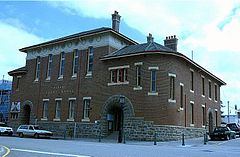
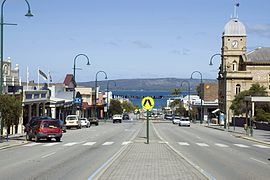








 Situated on the slopes of Mount Melville overlooking Princess Royal Harbour, this is a truly incomparable heritage listed building.
Situated on the slopes of Mount Melville overlooking Princess Royal Harbour, this is a truly incomparable heritage listed building.





























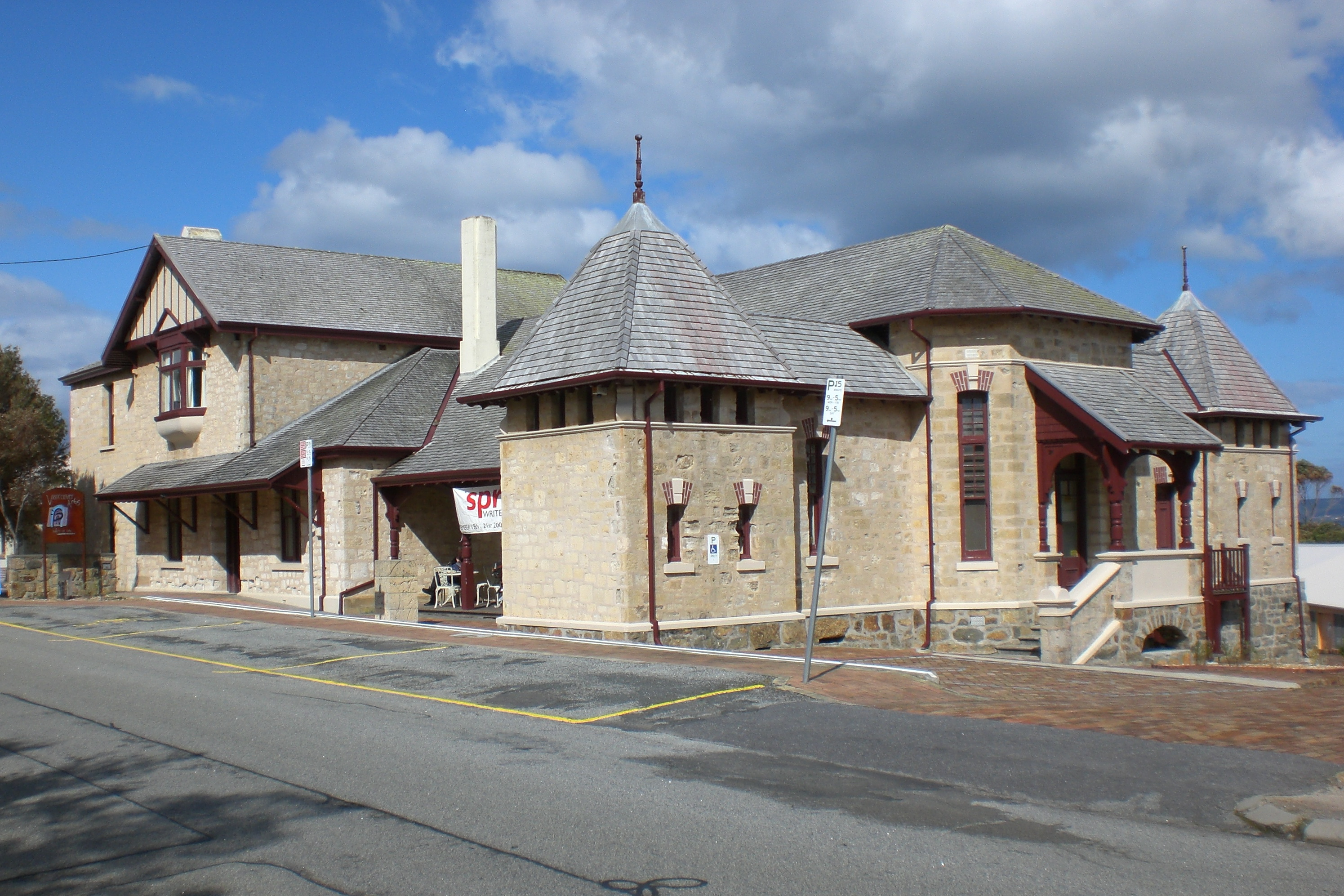
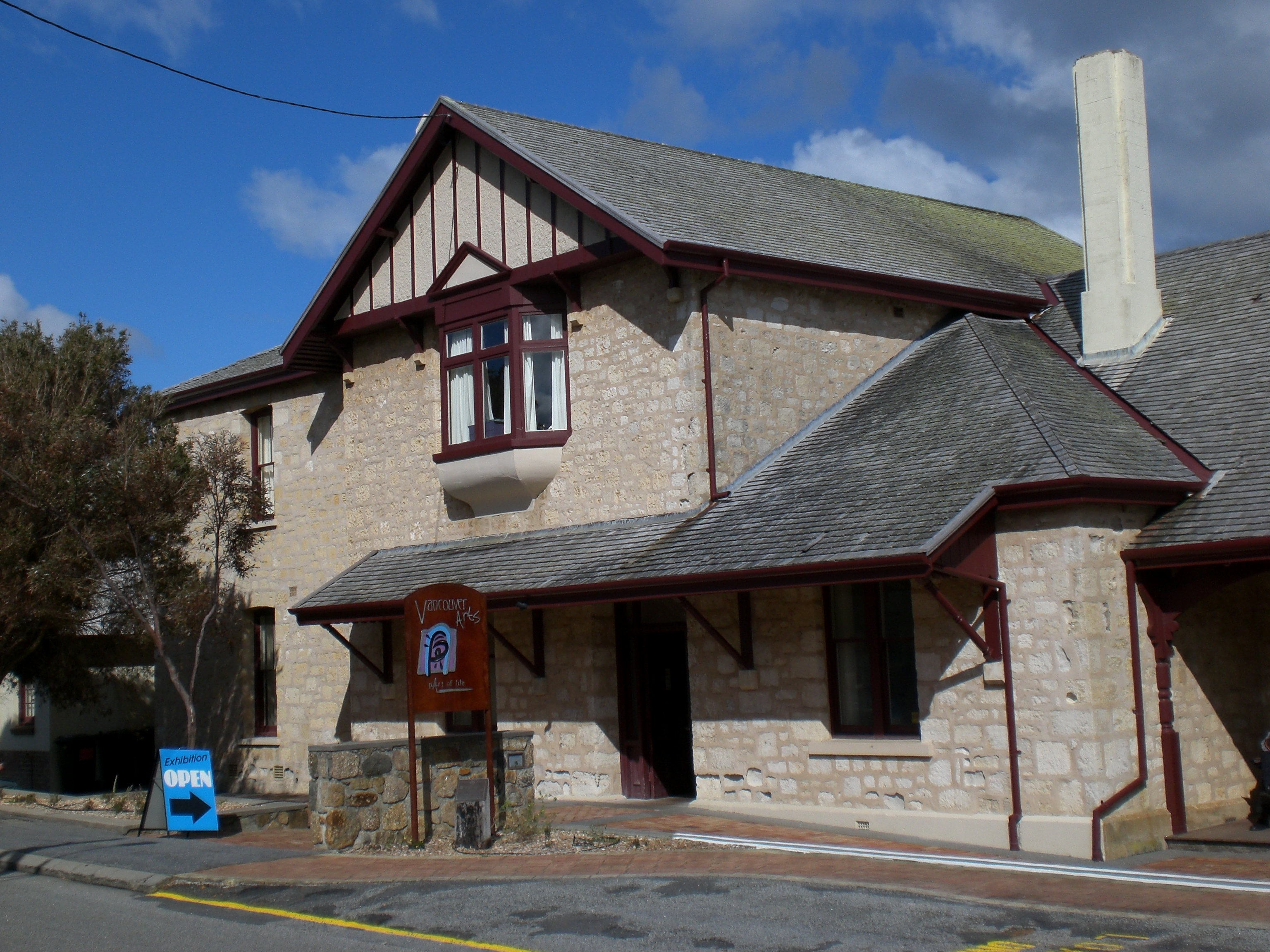

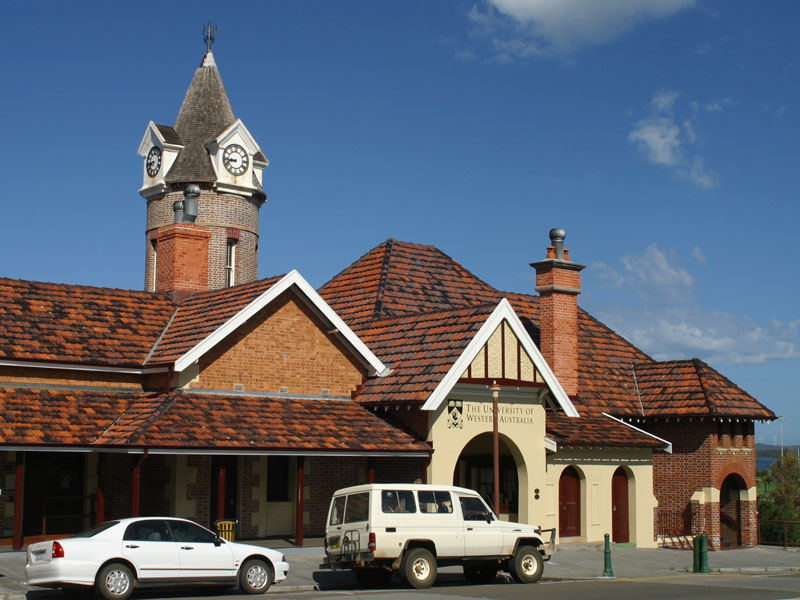

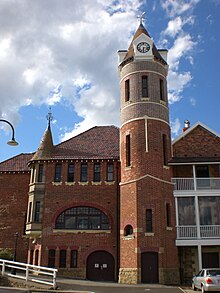


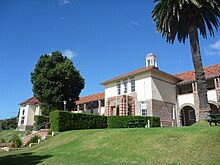















No comments:
Post a Comment